Hiking SoFo, South of Folkungagatan. Inspired by SoHo in New York, the neighborhood between Folkungagatan, Vitabergsparken and Götgatan has been renamed SoFo. With hangouts for game developers, advertisers, journalists and cultural creators.
Formerly a poor working-class neighborhood, depicted in Per Anders Fogelström’s five urban novels. Get to know Carl Larsson, Albert Engström, Slas and Dagerman during the walk.
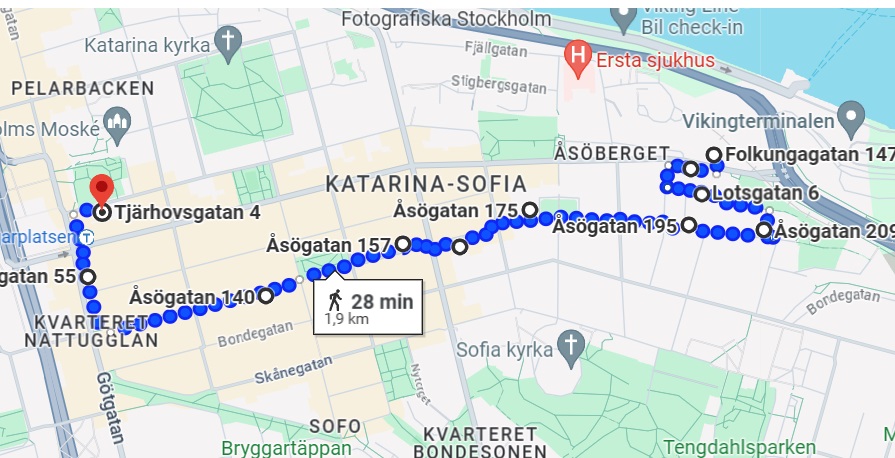
The walk starts from Folkungagatan, bus stop Londonviadukten. Which is neither a viaduct nor has anything to do with London. Other than that two Englishmen happened to be here when the place was renamed in 1910. Instead of the bus, you can walk along Stadsgården to Vikingterminalen, then 500 meters to Stop 1. If you are extra energetic, here is a continuation of Discovering the Pearls of Southern Sweden. Walk from Slussen to Fjällgatan .

Picture riddle: What is this that appears during the hike?
Template for teacher-led lesson based on this guide.
Stop 1. Folkungagatan 147, Shipbuilder’s Residence, a remnant of Stockholm’s largest shipyard.

The Shipmaster’s residence and office are the last remnants of the Södra shipyard , which was built from 1697 to 1910. The sailing ships required sawmillers and carpenters, who settled on Åsöberget. Replaced by sheet metal workers in W. Lindberg’s Shipyard and Workshop . One was the S/S Mariefred , which still plies Lake Mälaren. The rest of the shipyard has been demolished, replaced by Tegelviksplan and Vikingterminalen, which is the new name for Tegelvikshamnen. The residence is now an art school .
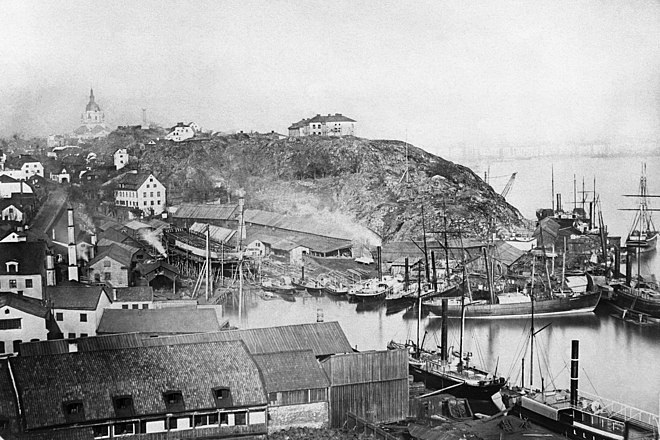
Brickworks with a harbor in the time of Gustav Vasa gave the place its name. Like the tar distillery for Tjärhovsgtan. Due to the fire danger, it was moved to Beckholmen, which made room for the shipyard.
See the map 1702-2024:
Stop 2. Lotsgatan 6. A worthwhile idyll in the sky
The promenade Sågargatan (after sawing lumbermen) and Lotsgatan to Åsögatan is worth seeing. Genuine cottage idyll, leafy park path and a wide view over Tegelvik harbor. Seafarers and shipyard workers drove their living quarters down the mountain where no one else wanted to live. Perhaps someone from the tar distillery sought refuge here, before 1687 when the business moved to Beckholmen. Hence the name Tjärhovsgatan.
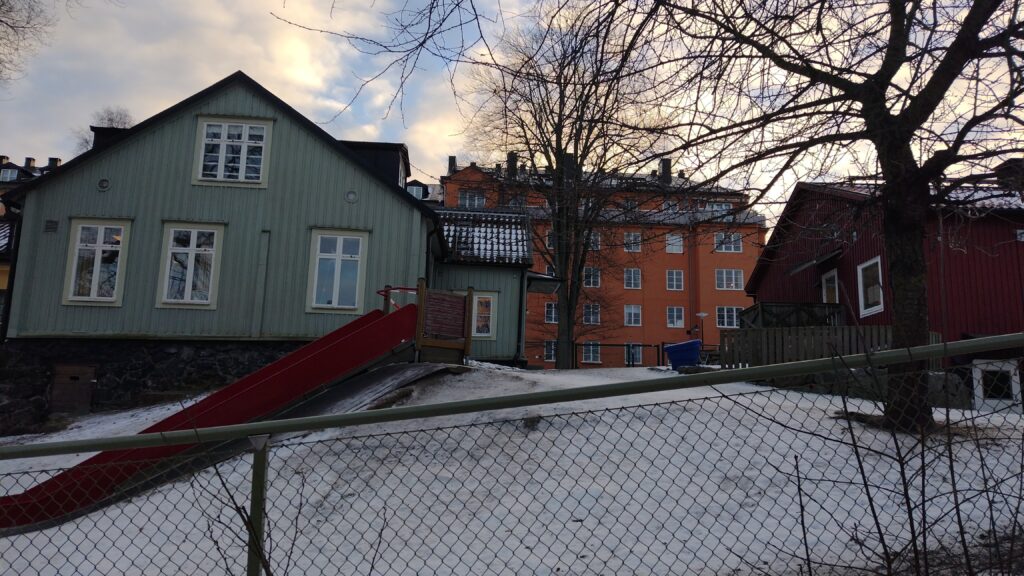
The painting made in 1885/86 outside Åsögatan 197-201 shows Carl Larsson applying his plein air painting technique in France. The children are sledding on the slope, between the apple trees that are also present in other motifs. The place is best seen from below the walkway on Lotsgatan. Because from Åsögatan a plank obscures the front of the house that houses a private preschool. Bedroom above. The maid Lotta, who he inherited from his in-laws, was allowed to spend the night as best she could.
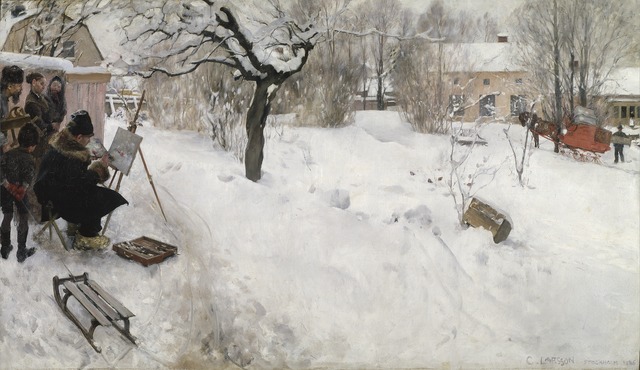
The painting is praised in Gothenburg, with the same apple trees in bloom and children playing. The family moves there because Carl Larsson becomes a teacher at Valand Art School, where Albert Engström was one of the students.
Painting outdoors was practical. The house felt drafty and cramped. Painting supplies filled the dining room, which was also the studio. Bookshelves were mixed with pots in the small kitchen.

Stop 3. Åsögatan 209. The house where the Fogelström family saga begins
Henning Nilsson and Tummen have settled down with two girls. Henning and Lotten get married and move into two rooms and a kitchen on the upper floor of the house on Åsögatan, near Åsöberget at the mouth of Duvnäsgränd. Which Fogelström calls Sopgränd after the broommakers, on the street that was then called Lilla Bondegatan.
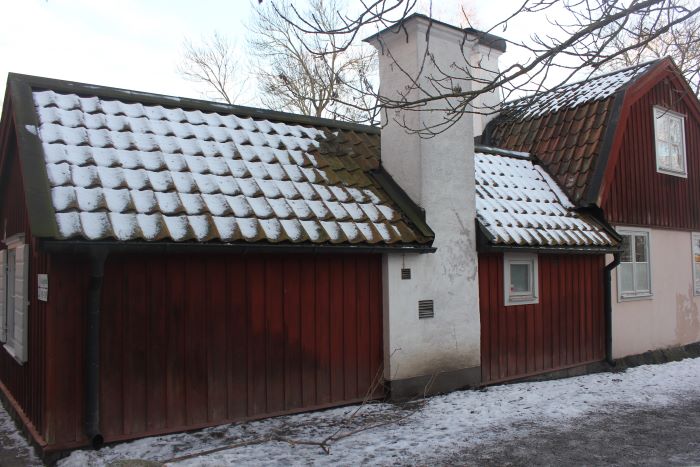
Unlike Tummen and Matilda, Henning Lotten gets married before they have August, Emelie and three more children. The internal crowding increases.
Tummen and Matilda live as unmarried people with the children on the lower floor, along with relatives and others who move in.
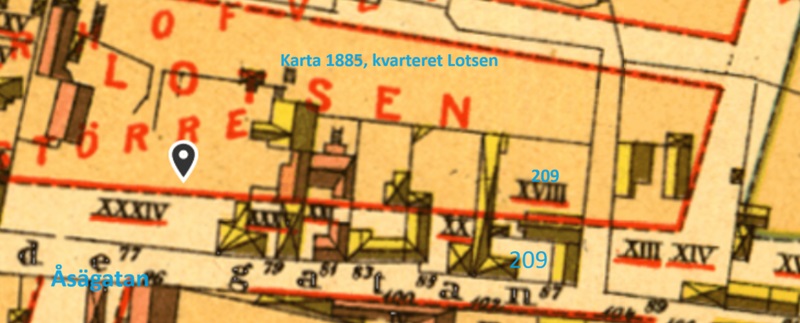
About Henning and Thumb in the City of my dreams, summer 1867: “On the way home they took a look at the cottage that was perched on the mountain opposite Tegelviken. Far to the well and a lot to shovel when winter came. But in the summer it must be lovely to live there, the view was just as nice .”

Today the house is in better condition, although a little dated and visible from the footpath before Åsögatan. A sign on the corner provides literary background.
The house was built on the rock outcrop in 1725 by the carpenter Nils Nilsson from Dalarna.
Stop 4. Åsögatan 197-201. Gloomy Carl Larsson’s front page
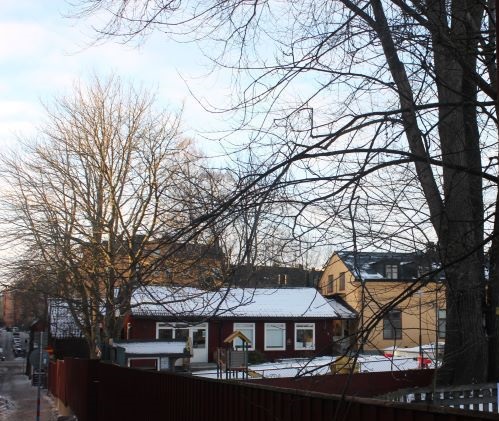
Carl Larsson’s life was not always an idyll. Periodic depressions hampered his painting. A poor childhood in Gamla Stan and on Ladugårdsgärdet. His father was a melancholic miscellaneous worker who beat. His mother toiled as a washerwoman for the family’s survival. Locked up alone at home, Carl found drawing a way to escape reality. His talent was discovered in the poor school and Gärdet’s elementary school. Which gave him a ticket to the Academy of Fine Arts, followed by studies for plein air painting in France. Then he and Karin moved into Åsögatan 197-201. It was cramped and stuffy, but the trees behind the planks were good subjects for paintings.
See Åsögatan looking east from number 201:
Before the stone houses were built on the other side of the street (203-204), there was an ore yard built by the shipbuilding merchant Charles Tottie in the 1770s.
Stop 5. Åsögatan 195 where Kolingen quartered

Albert Engström placed Kolingen as a guest with Fula Filip, who in turn was a guest with Feta Fille. Engström had studied with Carl Larsson, among others, at Valand’s art school in Gothenburg. Returning home at the turn of the last century, he lived on the part of Fjällgatan that became Mäster Mikaels gata. He saw run-down figures on their way to taverns and port jobs. Described in ”My first encounter with Kolingen and Bobban” . There were 30 thousand drawings of the alcohol-scented figures.
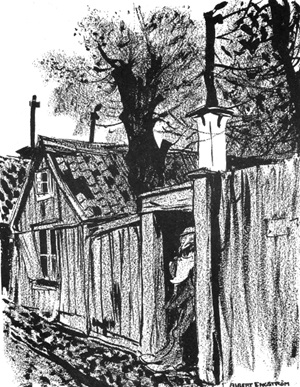
It wasn’t really as bad as the drawing shows. But it was poor, the shacks at number 195 were once a workshop. It was owned in 1700 by the lumberman Anders Persson and later by more lumbermen. Also sailors and tar shrimpers, because it was close to Tegelvishamnen. More about the houses in the Lotsen neighborhood .
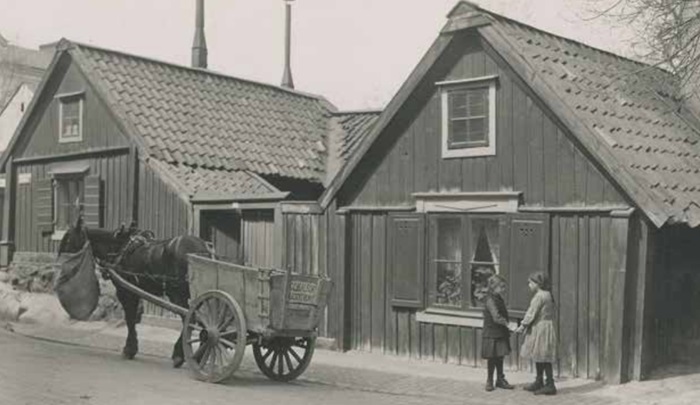
Soup 6. Stig Claesson’s park (Åsögatan 175-181).
GMap GStrV GoTo
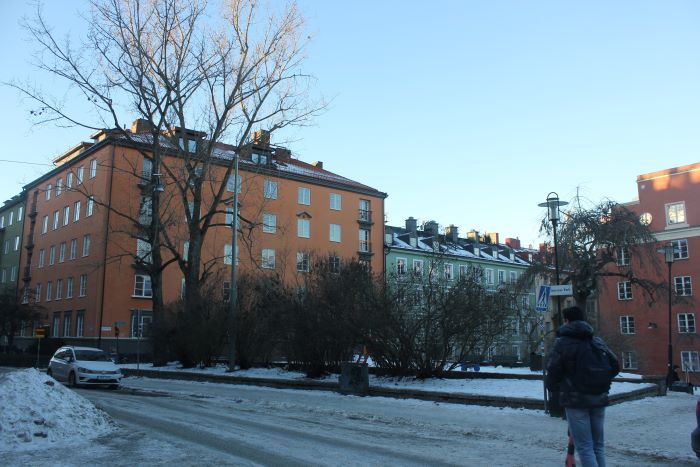
Named in 2008 after Sla’s death. Formerly Beckbrännarparken. Is a good resting place for tired legs.
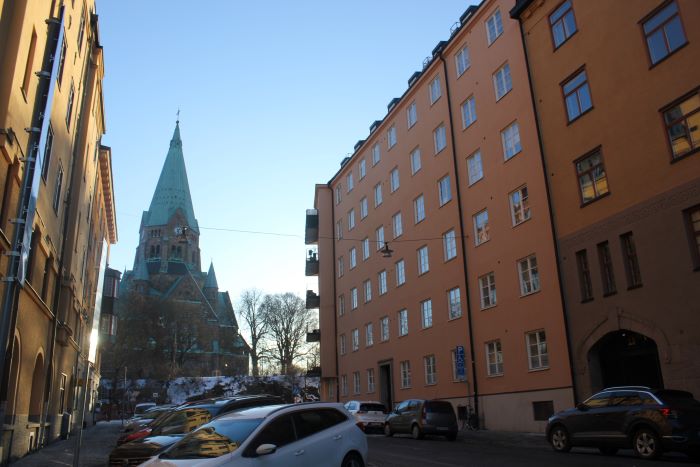
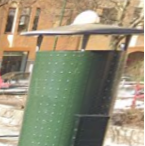
To the south is the house at Klippgatan 20 where Slas lived “on my mother’s kitchen sofa until I was 19”. Over here at number 19 is the “Jew House”, a foundation house for poor Jews who immigrated from Eastern Europe. Beyond, as a backdrop, Sofia Church. See Slas’ drawing from Klippgatan .
Clue for the picture puzzle. Convenient for the city’s native inhabitants.
Stop 7. Åsögatan 168. The stone house where Fogelströms Emelie rented a room with a kitchen
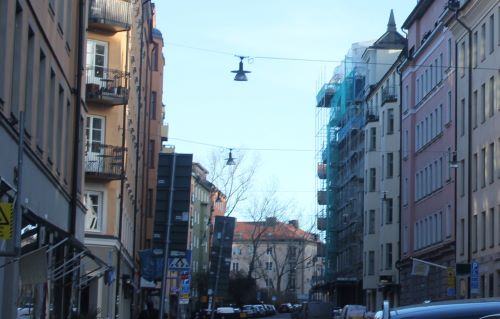
In Fogelström’s Minns du din stad, the farmhouse on Fjällvägen is demolished for the new Katarinavägen. In 1907, Emelie Nilsson moves with her siblings to the apartment building four flights up at Åsögatan 168. Built in 1883, the same house as today. Emelie in the kitchen, sisters Jenny and Börta with their children in the only room. Ten people in all on 40 square meters.

Stop 8. Åsögatan 157. The house where Stig Dagerman became a southerner
Stig Dagerman was born in 1923 and was seen as a southerner. But he only became one when he was eleven years old when he moved into his father Helmer’s apartment at Åsögatan 157. Father Helmer, the rock breaker who had become a municipal worker, had bought the one-room apartment for himself and his new wife. Stig Jansson, as he was called at the time, had a head for reading and did his homework at the kitchen table. He slept on the kitchen sofa next to the home distillery. Despite the alcohol, he had good contact with his father, but not so well with his stepmother.
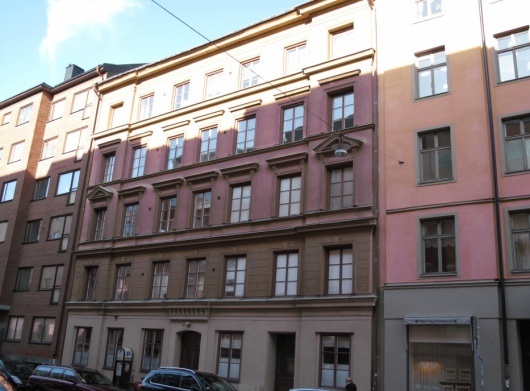
Although at first Stig had the surname Anderson, after the mother who rejected him after giving birth. A loss that Stig never got over. He was raised on his grandparents’ farm in Älvkarleby by the Dalälven River. There he was born and experienced his happiest time. And was buried after gassing himself in the garage in 1954 in Enebyberg. videos
Despite the alcohol, Stig had a good relationship with his father, whose syndicalism he inherited. Anarchism had already taken hold at Södra Latin. He then became editor of the newspaper Arbetaren, now with the new name Dagerman. The book Ormen was praised by the cultural elite and he became an icon for the forties.
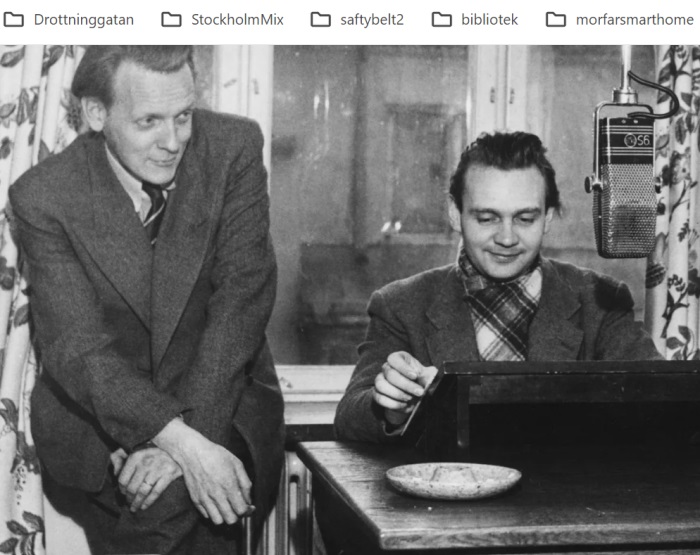
A highly sensitive vein permeated the production but was also a curse. Before the writing cramp led to depression, Dagerman published three novels, a number of plays, reports and poems.
- The Snake (Ormen, 1945), översatt av Laurie Thompson, utgiven 1995 Wikipedia+15Wikipedia+15Alba+15
- Island of the Doomed (De dömdas ö, 1946), översatt av Laurie Thompson, utgiven i USA av University of Minnesota Press 2011/2012 upplittmagasin.se+5Wikipedia+5dagerman.us+5
- A Burnt Child (Bränt barn, 1948), första engelska utgåvan 1950, senare som A Moth to a Flame (Penguin European Writers, 2019) med förord av Siri Hustvedt Alba+5Wikipedia+5Wikipedia+5
- Wedding Worries (Bröllopsbesvär, 1949), översatt av Paul Norlén och Lo Dagerman, utgiven på engelska 2018 Wikipedia+14Wikipedia+14Alba+14
Interlude: Dagerman and Stieg Larsson’s life story ends in Södermalm.
Dagerman and Stieg Larsson with the Millennium Books (videos) have much in common. Both anti-fascists.. Dagerman was active in Syndicalist Youth. There he met his first wife, AnneMarie Götze – who had an anarchist past in Hitler’s Germany and the Spanish Civil War. Stieg Larsson was active in the Communist Workers’ Union in the 80s.

Both workaholics with unhealthy lifestyles that led to early death. Dagerman in the syndicalists’ Storm and Arbetaren. Stieg Larsson died on the steps of Expo, the magazine he started in the fight against racism and neo-Nazism.

Both were close to their maternal and paternal grandparents, politically radical parents who lived on small farms where they spent their childhoods. Dagerman in Norrgärdet in Northern Uppland. Larsson in Bjurträsk in Västerbotten. Dagerman was 12 when his grandfather was murdered by a mentally ill person. His grandmother died soon after. A loss that may have contributed to a number of suicide attempts. Stieg Larsson was nine when his grandfather died and he had to move back home to his parents.
Answer to the picture riddle: the urinal in Axel Landqvists Park, Åsögatan 148.
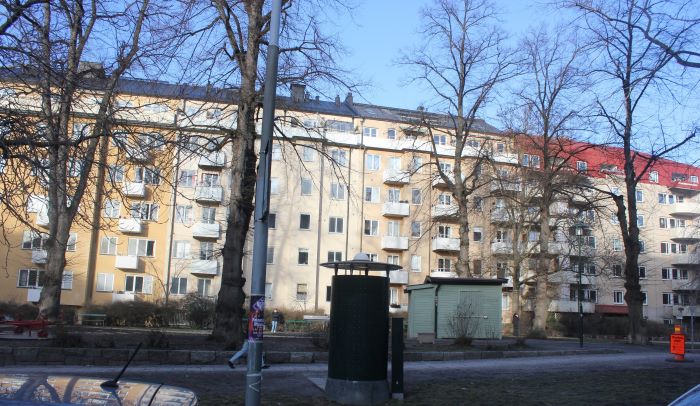
Stop 9. Åsögatan 140. The four-room incubator for the world’s third most successful computer game
Åsögatan no. 140. years 2010-2012. A worn four-room house with a single toilet. Overheated by computers and a score of computer nerds cracking code for a Lego-like computer game, Minecraft. Half a million followers on Twitter. Five million paying customers who paid for games for 650 million SEK. Figures that were valid in 20132 when Mojang AB in 2012 from Åsögatan to Maria Skolgata 83 near Södra Station.
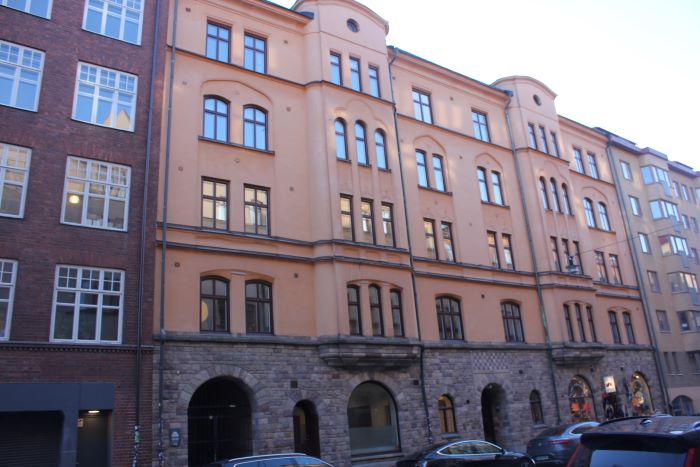
In 2014, Microsoft bought Mojang for 18 billion kronor, of which 13 went to Markus “Notch” Persson. He was able to get a driver’s license and buy a luxury villa in LA for 70 million dollars. At the time, the highest-paid house in Beverly Hills

“Why aren’t you out playing with the other children?” worried mother Ritva. Shy eight-year-old Markus wanted to play with his Commodore. Under the cork oak, if there was one in Roteberg, a residential community outside Edsbyn. Their Smyrna parish had helped the troubled family move from Stockholm. Father Birger, who worked on the railway, was Markus’ support but alcohol brought separation. Mother Ritva moved with the children to Salem where Markus received a high school diploma in computer science at Tumbaskolan.

That’s where the Minecraft saga begins, albeit with a touch of sadness. His father shot himself in 2011, which took a toll on Markus. His sister also abused drugs but recovered. His one-year-old marriage to Mojang programmer Elin Zetterstrand broke up in 2012. Working 24/7 and taking care of young children was not a good combination.

Notch Persson, Dagerman, Stieg Larsson. Three dandelion children whose fates strangely converge on Södermalm. A tangled upbringing, Stockholm – Northern Sweden round trip. Grief work after supportive relatives. Workaholics. Ingeniously creative. Politically radical, albeit only the Pirate Party and donations to U-hjälp for Notch. ”I’ve Never Felt More Isolated” says Persson . Dagerman with writing cramps , anxiety and in debt to the publishers. Threats from right-wing extremists forced Larsson and his partner to hide behind a steel door, alarm and secret address
Minecraft is the world’s best-selling computer game with 200 million copies . Is Åsögatan a cult place for game fans? Mojang AB, renamed Mojang Studio , has been located in the former brewery at Söder Mälarstrand 43 since 2018. But at Åsögatan 140, nostalgia can get a kick with pop stuff from the vintage store Pop Stockholm. Åsögatan may seem boring, but it’s the quirky shops and cafes there that are SoFo’s charm.
Stop 10. Götgatan 55, Göta Lejon. The hanging place with a sup for those who haven’t been hung yet
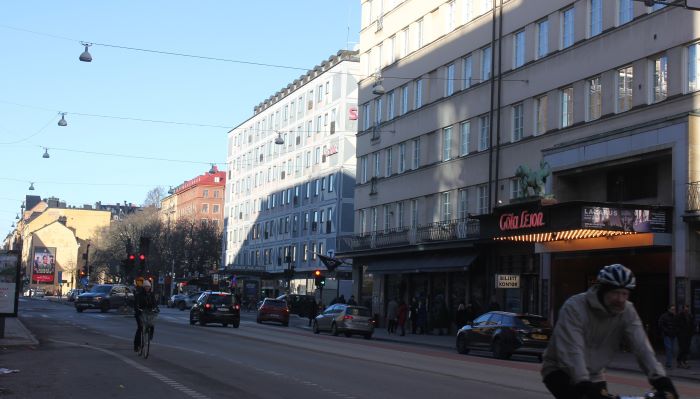
Today the Göta Lejon musical stage, during its heyday Stockholm’s largest cinema.
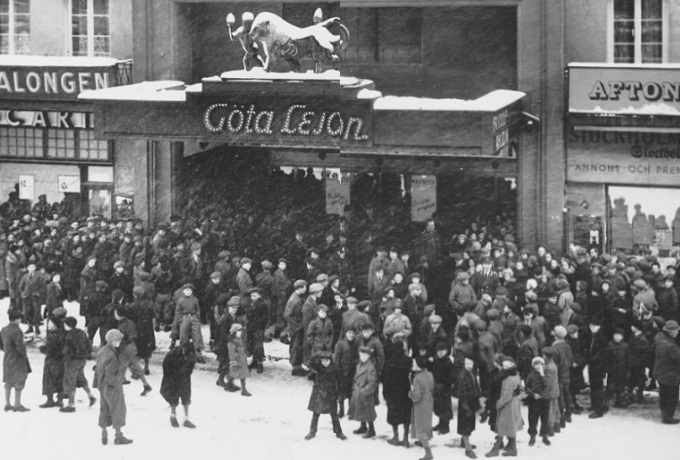
It was not without reason that Götgatan was called Stockholm’s Broadway, with a street lined with eateries and cinemas. Greta Gustavsson walked here and later appeared as Garbo on the Göta Lejon cinema screen. 500 meters from where she grew up on Blekingegatan.
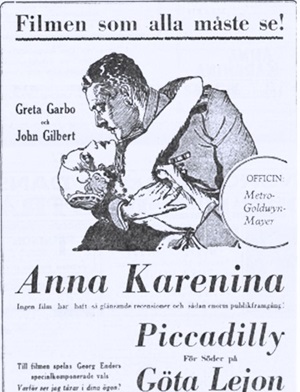
Before 1908, there was the Hamburg cellar at the intersection of Götgatan/Folkungagatan, where those condemned to death had a last drink before being taken to the execution site at Hammarbyhöjden. The names were carved into the shot glasses for the guests’ enjoyment, but no longer because the collection was purchased by an American.
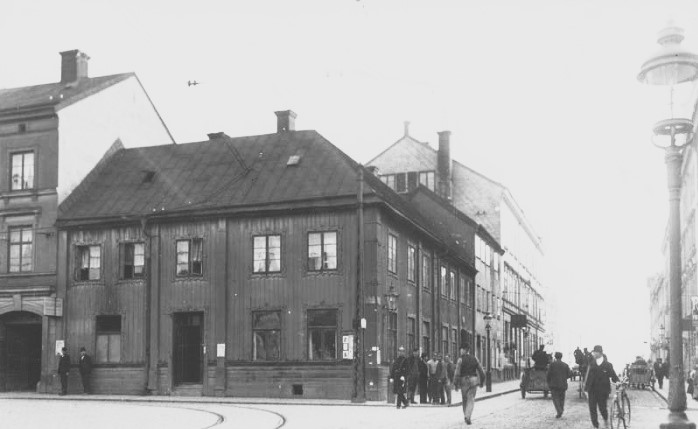
Götgatan after Göta landsvä g, which was the city’s most important exit south, past Skanstull.
Anyone who has read Stieg Larsson’s books will find familiar places. Next door to Göta Lejon on Götgatan 53 is the Tapas restaurant. In the same place as the Hamburg cellar and Café Eden in Stieg Larsson’s The Girl Who Played with Fire.

Wearing glasses and a wig, Lisberth Salander sneaks camouflaged as Irene Nesser from Mosebacke to the café where she orders a baguette and a caffe latte. Then she rents a Nissan Micra and goes to Ikea in Kungens kurva.
Stop 11. Medborgarplatsen Götgatan 54-56. The swamp that became a train terminal and community center
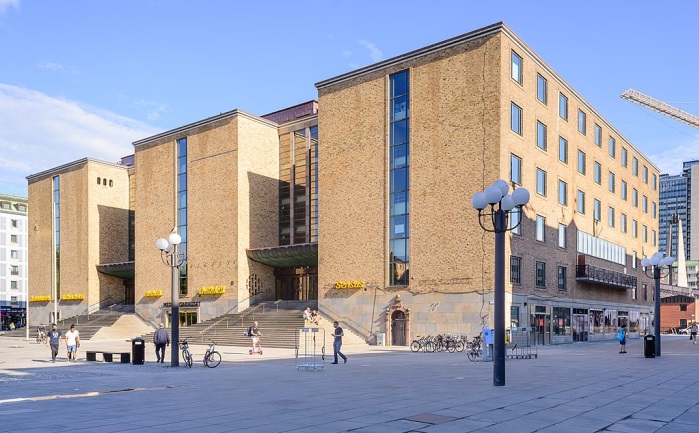
Today Medborgarplatsen at Götgatan . Formerly a rural idyll on the Götha highway. Fresh water and fish were collected from the lake and stored in guest house sheds, hence the name Fatburen. Until the 18th century when ditching and garbage caused the lake to grow again. Where mosquitoes spread malaria to poor people. The swamp was drained to make room for the main line’s terminus at Södra station, inaugurated in 1870. Goods from the country were sold from stalls on Södra Bantorget. Nowadays, only the commuter trains stop at Södra station.
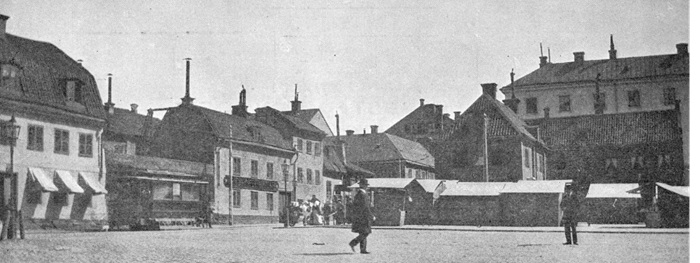
In the 1940s, Södra Bantorget was renamed Medborgarplatsen. Medborgarhuset, actually three buildings, was filled with auditoriums, a library, a gym and the Forsgrenska bath; Medis called it. On the outskirts, Fatburen remained as puddles. With a slum that was replaced by the houses in the Södra Station area, crowned with Bofill’s arch. The only traces of the lake are the names Fatbursgatan and Fatbursparken.
Stop 12. Björn’s Garden Götgatan / Tjärhovsgatan 4. Green refuge for both the downtrodden and the green scarf people
Björn’s ore farm from the 17th century can be traced in Björn’s garden . Where Kolingen’s followers like to camp, close to Babylon’s bar hangout . Although the rumor that Stockholm’s most dangerous place is rather exaggerated.
Things got heated when Reclaim the City occupied the street and Björn’s garden . Lisbeth Salander happened to pass by and was beaten with a baton by a police officer wearing a visor, page 227 of Men Who Hate Women .

The historic beer hall Kvarnen on Tjärhovsgatan 4 is a popular hangout for Hammarby fans. Both before and after the match, to celebrate the victory or a big beer to drown the sorrow. The director Janne Halldoff was often seen at Kvarnen. He grew up near Nacka Skoglund’s home on Katarina Bangata. About whom Halldoff directed the play Dribblern. Perhaps he met Monica Zetterlund who had a regular table at Kvarnen.
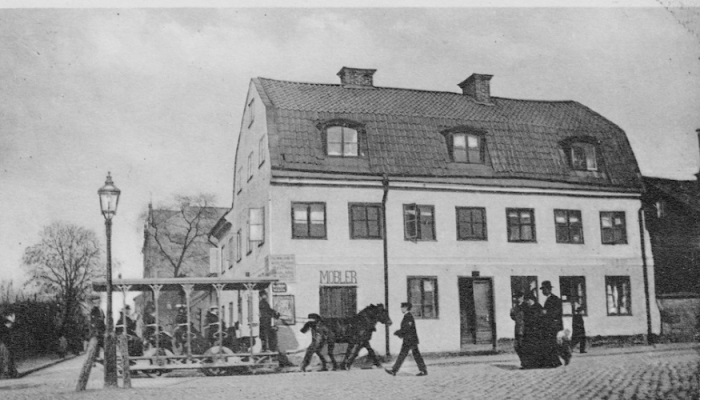
Lisbeth Salander and Miriam Wu kissed there before spending the night in the apartment on Lundagatan, The Girl Who Played with Fire page 356. They used to be part of a girl gang, Evil Fingers, who lived as robbers at the Mill; page 334. Look in there, because maybe there is someone there who looks like Lisbeth, see page 442 and onwards in the same book.

Quiz questions for this hike. Click.
/ By Ingemar Lindmark
